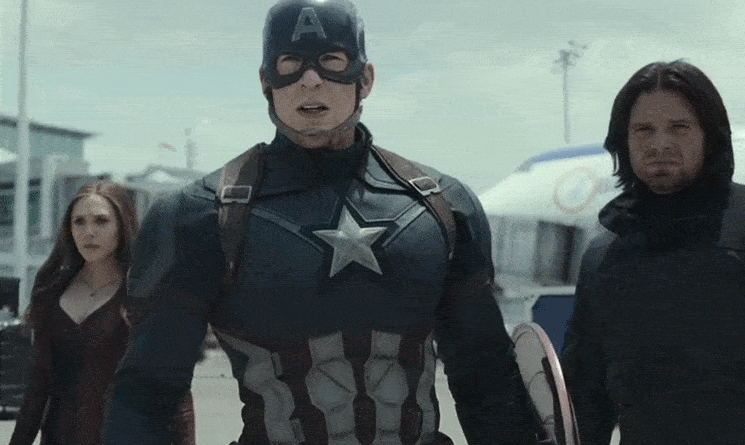This whole Marvel experiment, with the sharing of multiple characters and their various story lines stretching across one cohesive long-form arc, really seems to be working out. The Marvel Cinematic Universe straddles a unique space between conventional standalone films and a television series’ facility to patiently describe the effects of events — comic, tragic and otherwise — on the personalities of people we come to empathize with through time, investment, and familiarity.
In the eight years since Tony Stark (Robert Downey Jr.) stood up at that press conference and told the world he was Iron Man — effectively dismissing in one stroke the entire “secret identity” trope of previous superhero sagas — we’ve become intimately acquainted with a whole parade of very distinct, fairly complex figures, each with their own quirks, virtues, powers, and yes, flaws. Over the course of the 12 movies that have led us to “Civil War,” we’ve been given the opportunity to watch as these folks, played with few exceptions by the same actors in each outing, have grown together on screen, and in our minds, as an unbelievably interdependent fighting team, and as something closely resembling a family.
“Captain America: Civil War” is the culmination of what Marvel has been calling Phase One and Two, in which we have been gradually acclimated, step by meticulous step, to increasingly implausible and preposterous phenomena. A high-tech mech suit was easy enough to accept. Then a chemical process transforming the frail into strong-men — hell, you can buy something like that at your local Rite-Aid (and just as in their world, results may vary). Mad scientists? Sure. Tissue-regenerating nano-bots? OK. Then, well… then they snuck in gods. GODS. And from there it just got weirder. Giants, alien bug armies, mysterious inter-dimensional power stones, globally homicidal killbots, and they even rolled out a talking duck named Howard. With a martini.
Through all their strange tales of courage and valor and strife and loss, this band of unlikely compatriots has been, as we the audience have been, inexorably forced to accept that even the best of intentions can yield terrifyingly unpredictable consequences. Their heroism gives rise to greater villains. Their attempts to push back against the chaos of the world results in varying degrees of devastation, pain, and death. It all begins to take a real toll on their ability to keep fighting the good fight. Tragic secrets are revealed, wounds deepen, fractures form, inherent ideological divides grow more pronounced and impossible to ignore. Some of our friends here, in fact, are completely blinded to each other’s viewpoints by the very purity of their guilt, confusion, doubt, and self loathing.
We’ve been given time to become invested in all of these people, and it works. Schoolyard brawls happen. Schoolyard brawls between friends leave scars.
This inevitably leads to some very awkward family dinners. And, turns out, punching. Lots of punching. High powered, tech-enhanced, Earth-rumbling, supersonic punching. And missiles and laser beams and telekinetic body hurling and more punching. Don’t worry, if fisticuffs is your bag, it’ll get punched and plenty.
Yet somehow, undercurrent to all this madness resides a deep concern to see if Tony Stark’s iron shell of insecurity would ever allow room for true closeness, or if a resurrected Captain Steve Rogers (Chris Evans) could ever find comfort in a world where he doesn’t belong. It’s a testament to the architects who designed this ridiculously complicated and self-perpetuating system that, amid all the outlandish adventures, and among all the assassins and geniuses and super-soldiers and floating robot butler demigods, it’s the personal conflicts that continue to be the central ones.
Once again, bravely throwing convention to the wind, Marvel has discarded its own formula and avoided any hint of drone troop hordes and dropping battleships and mountains on unsuspecting innocent bystanders, and managed to orchestrate the Avengers’ biggest challenge: simply to stay together. There’s barely one villain involved in “Captain America: Civil War,” and even he’s got good reasons. They all do. It’s fascinating to see these people wield their insane powers in an attempt specifically to not kill each other. There’s genuine compassion behind all the anger. The hits land that much harder for having so many years of emotional context, and the reason all this works is that we care. We’ve been given time to become invested in all of these people, and it works. Schoolyard brawls happen. Schoolyard brawls between friends leave scars.
It’s fair to say that comics were born from adolescence, from the dream of the small to escape into the large. It’s the same fuel that drives many great movie experiences. The secret to good comics has always been that a core of fragility remains under the most steely of surfaces, and the real fight is finding balance between the two. The greatest achievement of “Civil War” is that it offers, amid storms of (very satisfying) puerile outbursts, a maturity that allows this balance to go unresolved.
Captain America has always been the True North of the Marvel Cinematic Universe, even as he’s followed a path from the perfect patriot to straight-up insurgent, and it’s perfectly, and dramatically, appropriate that it’s his movie where the roads of the last 12 converge, and the inevitable collision of all these trajectories finally just blows the whole thing to bits. Like the best comics, it leaves one dying for the next installment. Bravo, Marvel. When’s the next issue come out?

